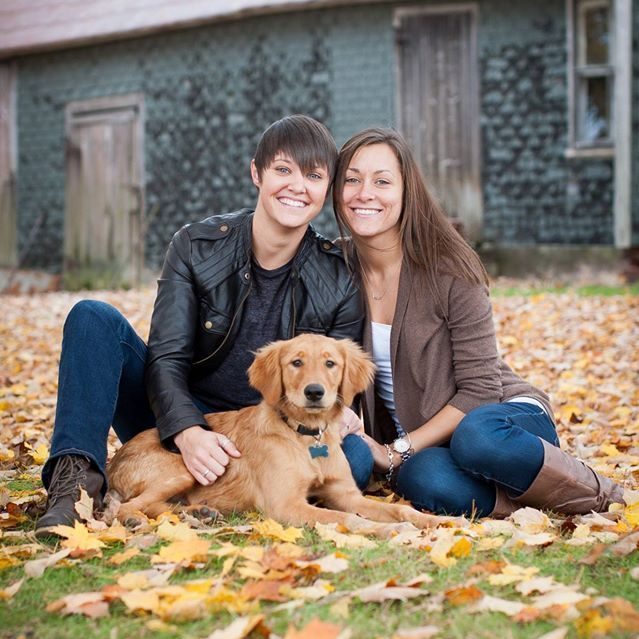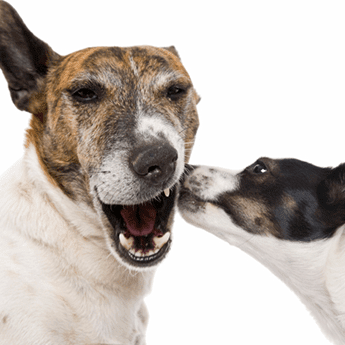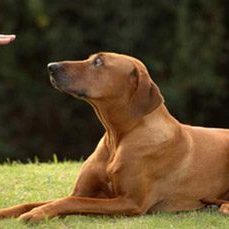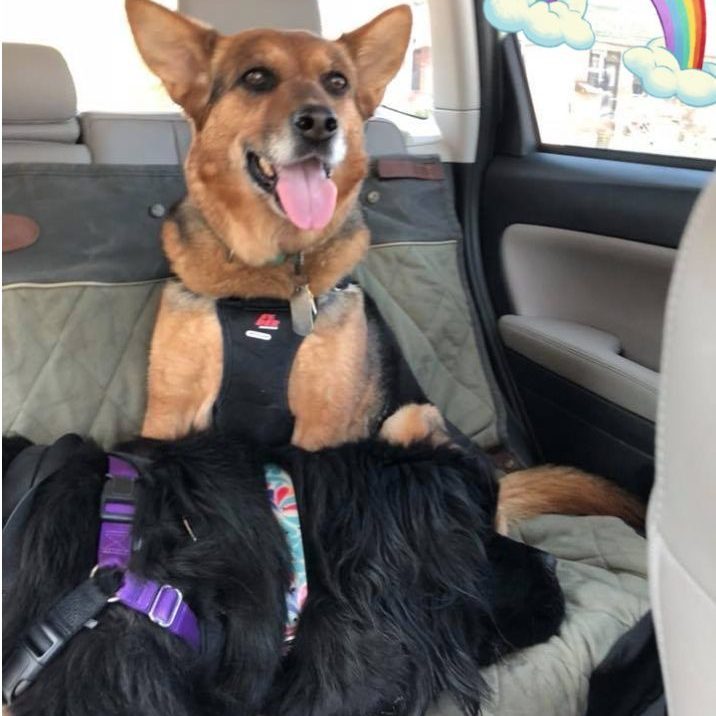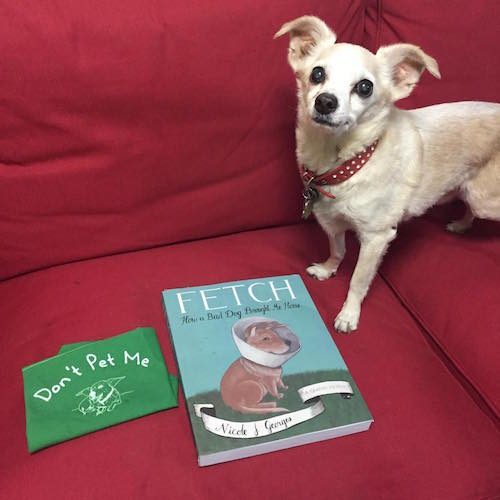
Don’t wait to FETCH this new queer dog book – An interview with comic book artist Nicole J Georges.
Nicole J Georges’ poignant and hilarious comics brilliantly capture not only the ups and downs of queer life but even more importantly (to me at least) the intersection of that with the tender reality of a life intertwined with dogs. I first became familiar with Nicole’s work when we were both living and making zines in Portland, Oregon in the early 2000s.
My oldest dog Mercury was a little puppy running around the Portland Zine Symposium and In Other Words Feminist Bookstore at the same time as Nicole’s dog Beija who is the subject of the new book FETCH: How A Bad Dog Brought Me Home. FETCH is unlike anything I’ve read before. Cover to cover, FETCH is filled with bold, captivating, illustrations that brilliantly capture the relationship between a young queer girl and her dog.
Nicole was kind enough to talk with me about queerness, dogs, and her creative process—check it out!
How did you get the idea to write a book focused specifically on your life with Beija?
In some ways, I have been writing this book about Beija since I was 16 years old. That is when I started cataloguing our time together and drawing our lives.
After she died (spoiler alert), I took myself to White River Junction Vermont, for a fellowship at the Center for Cartoon Studies. I was there, driving cartoonist Chris Ware to school from the airport one day and rambling on about Beija and how she was like the baby I had in high school.
He off-handedly said, “Oh, that would make a good line in a graphic novel. This dog was like the baby I had in high school.” I was inspired! The deal was sealed! He didn’t know it, but he lit a path that I followed to my next book.
How has a background in zines and zine culture influenced your approach to writing/publishing books?
I am not precious, I just get to work. I think a lot of cartoonists, outside of my queer, feminist, DIY literary scene, can be competitive with each other or feel like they deserve some modicum of success.
I don’t believe that being rewarded by capitalism equals artistic success. My art isn’t better or worse than someone else’s just because it is in line with what a publisher likes and wants to invest in. That is a value that I think is rooted in punk feminism and DIY culture/zines.
Also, as a marginalized person, I don’t believe in competition. I don’t believe in being motivated by scarcity. There is enough for all of us, we just need to bust through and take up that space. I want to help other people up because other people have helped me. I’d rather focus on that than try to compare myself to other people’s careers and imagine they’re having some imaginary better time than I am.
FETCH is a lengthy book and you do a beautiful job of interweaving stories. How do you approach outlining or deciding which stories to include in a book like this?
When I set out to do a book like this, I write a big timeline for myself, knowing what I want to put at the beginning and what I want to put at the end. Then I fill in the milestones between and try to do writing exercises and free-writes with myself about any other possible anecdote that feels important. I physically line all these up with tiny bits of paper and see what resonates, what stories are essentially saying the same things, what can be stripped away and what’s left. Then I thumbnail it, edit it again on my own, thumbnail it AGAIN for readability and take it to an editor.
What is your creative process like when you’re working on a book? What comes first the drawings or the words?
I think the ideas come first, so I write them down like headings or section titles, then I sometimes do a free-write on a particular place or person and try to include those details in my mind as I draw. I thumbnail first. That’s kind of like a simple version of storyboarding. Just to get the ideas out of my head. The drawings are as important to a graphic novel as the words. They each serve a different purpose and enhance each other.
A flyer of Beija’s “I’m not a stuffed animal” manifesto used to hang tacked to my (punk house) living room wall in Portland. I love that it’s included in FETCH! Can you talk a little bit about how you hope your work shifts people’s understandings about dogs and their right to assert boundaries?
Dogs are individual beings who don’t belong to us. We are their shepherds, and sometimes protectors, but they don’t OWE anyone fur-touching time. Just like I don’t OWE anyone a smile on the street as a woman. It’s a weird narcissism people have, trying to control other individual beings into doing the thing that would make *them* more comfortable.
My dog Beija wasn’t good or bad, she just was. And she was shy. People could not understand why a dog existed not to please them, so they called her crazy or vicious or bad, but none of that was true. She was a shy dog, I said “don’t pet the dog,” people tried anyway, and she barked at them.
There’s nothing wrong with wanting to bond with an animal, but just ask! Ask the person, ask the animal, let them sniff, see if they’re into it. If they say no, get over yourself and go rub a pelt or something.
I loved your depiction in the book of what it was like to come out. How does being a gay artist/author impact your work?
Thank you! I don’t know if being gay does impact my art outside of the fact that I get to be in a community of smart, funny, like-minded individuals and I am so psyched to rep for our team.
Do you see queer liberation and animal liberation as connected?
I see all liberations as connected. It’s all about dominance and supremacy. I know people don’t like that because they think it sucks to be equated with animals, and that’s their right, but I don’t think it’s so awful.
I just don’t believe anyone should feel entitled to dominate another autonomous, living being. That’s it. No one on this earth is here to serve me or for me to step on, in the same way, that I’m not here to serve anyone or to tread on.
“My only sense of quiet, consistent comfort was with my pets. Even as I was confused with inescapable rage and dysfunction, my heart in a black broken knot, they came through. Animals.” I loved this line and could so easily relate to many of the stories in FETCH about the painful parts of childhood, and the comfort that pets brought into those dark places. How do you approach writing about the people who have hurt you?
I tried to only include things in the book that moved the story forward. It felt important to me to include my feral childhood because I think that illuminates why I felt so protective over my own dog, Beija. It felt important to include my romantic relationship because our breakup brought me to the lowest point of my life, from which Beija helped me climb up.
If I ever write someone doing something crummy, I want to include them doing something kind. Because that’s how humans are. None of us is good or bad. I don’t want to ever use my platform, or my work, to drag anyone else down (I’ve become more and more and more mindful of it as I’ve been doing autobiography for 20 years) but I also want to tell an emotionally honest story from my own perspective.
I really identified with the section where you discuss being a teenage mom to Beija. So much of my late teens/the early 20s was defined by parenting dogs. What advice would you give to young readers who are in similar positions?
This is some pre-dog advice, if I may: Do not let your emotions guide you into pet ownership.
I will never regret having Beija or being close with her. She shaped me. She was my heart. However, having a dog is a huge responsibility, and I’m not sure if one is necessarily suited for that responsibility before they have a fully formed frontal lobe and know what they want to do with their life. It’s like marrying your high school sweetheart.
You never get the chance to explore and try other things to see if that’s what you really want because you have lashed yourself to the familiar. It is like both growing up very fast and not at the same time.
So travel, explore, try living alone, trying living with people, read about dogs, walk dogs, volunteer with dogs, figure out your work schedule, and get a good understanding of what kind of dog is best suited for the life you can provide BEFORE you adopt a dog.
Can you tell us a little about your new (ADORABLE!) dog buddy Ponyo who we meet at the very end of Fetch?
Ponyo Georges is a very good dog whom I met at the Oregon Human Society when I went (initially) to look at a very grouchy hoarded poodle. (My best advice is: Listen to the people who work at the shelter about who is the best dog, and do not be swayed by the way a breed looks)
Ponyo is a Chihuahua/Pomeranian/Shibainu mix who was found as a stray in Merced and acts like she’s never known a moment of adversity in her whole life. She loves every stranger and she travels with me everywhere. She loves cartoonists and queer people, in particular. She is blind in one eye but she doesn’t let that stop her!
What is Ponyo’s favourite treat?
Ponyo lives for fetching, so the kindest thing you could do for her is to throw a tennis ball or a bone. As for food, she likes disgusting things like fish skin, any meat that a stranger will feed her (I’m vegan, so my treats are way boring and if you give her roast beef she will disown me and become yours forever), or any tiny bite-sized training treats.
Anything else you would want to say to a (mostly) lesbian reader?
Be nice to animals, and Sisterhood is powerful!

